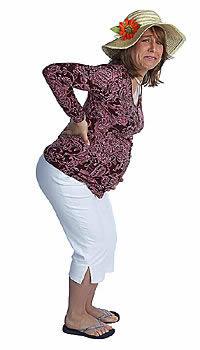Acute back pain is a common occurrence for about 80% of the American population; unfortunately 5-10% of this group experiences a more severe back pain that is called chronic. Back injuries are normally the cause of disability for adults under 45 years of age, people who are employed in construction, operating machinery, and nursing are often at a higher risk for developing lower back injuries.
The most common forms of back injuries that cause chronic pain include herniated discs, osteoarthritis, compression fractures, and spinal deformities. Often it is prescribed by doctors to avoid bending, lifting, and twisting, gardeners do not have to give up the love of gardening for these reasons.
Make Plants Accessible
 Raised beds are becoming a very common trend. The addition of a raised bed to your setting drastically reduced the amount of bending required to care for your plants. Less bending means less stress on your back. Plants normally require 6-8 inches of soil to thrive, so be placing your garden on a table or stilits, you can still enjoy a full garden!
Raised beds are becoming a very common trend. The addition of a raised bed to your setting drastically reduced the amount of bending required to care for your plants. Less bending means less stress on your back. Plants normally require 6-8 inches of soil to thrive, so be placing your garden on a table or stilits, you can still enjoy a full garden!
When designing a raised bed, it is important to consider many aspects. Be sure not to make your bed to wide or too long, suffered of chronic back pain should not have to twist or bend to reach the middle of the garden. Sufferers of chronic back pain should create a raised garden that is no more than two feet away from the other sides. Also remember that the deeper your soil level, the heavier the bed will be. Make sure to have adequate drainage for your bed, so your plants do not rot out.
Raised beds will dry out much quicker than gardens in the ground. Make sure to check the soil often, and water more frequently. It may be necessary to water a raised bed twice a day if it is a dry season.
Since the water will need to run out of the bed, it can steal valuable nutrients as well. Raised beds may require some extra fertilization as a result. Just keep a close eye on your plants to determine if they need fertilization or treatments throughout the growing season.
If the idea of a raised bed seems like too much work or unappealing, try using containers for plants. Planters come in a variety of sizes and shapes that you are sure to find a style that you enjoy. These pots can be placed on a counter, a table, or a shelf so you won’t have to bend or twist. The same rules regarding watering and fertilization apply to containers as to raised beds.
Plant Choices for Chronic Back Pain
If the above ideas are simply not an option for your budget or taste, it may be necessary to consider plants that will make your job easier. Consider a head of lettuce that needs picked less frequently that other delicate micro greens. A vine that climbs over a trellis will be much easier to care for than mounds of annuals that require heavy maintenance.
When it comes to tasty fruits like tomatoes and melons, consider adding a fence and train the vines to grow up, instead of spreading out over the ground. This eliminates the need to bend when it is time to harvest the fruits. This technique allows your fruit to stand out, and will help to keep it from rotting out as well.
Choose tools that will help your gardening technique as well. Keep a hoe, rake, and cultivator on hand, as these will work as extensions of your body, allowing you to maneuver without bending or twisting.
These simple ideas will allow sufferers of chronic pain to continue to enjoy this wonderful and productive hobby. Just consider your back before you design a garden or choose your plants!
